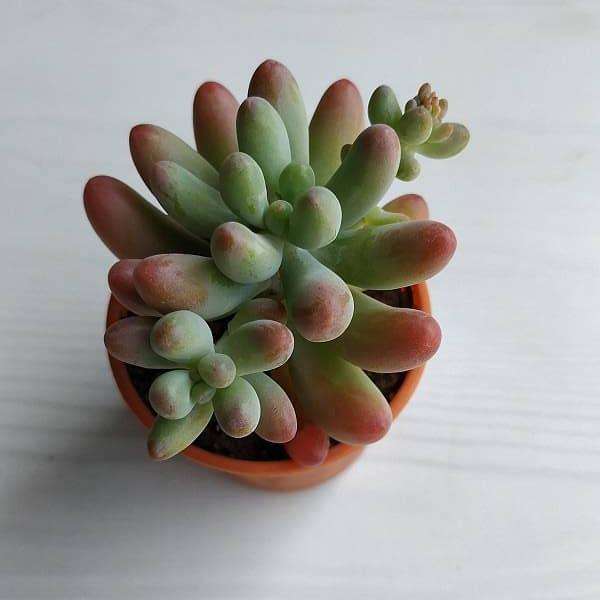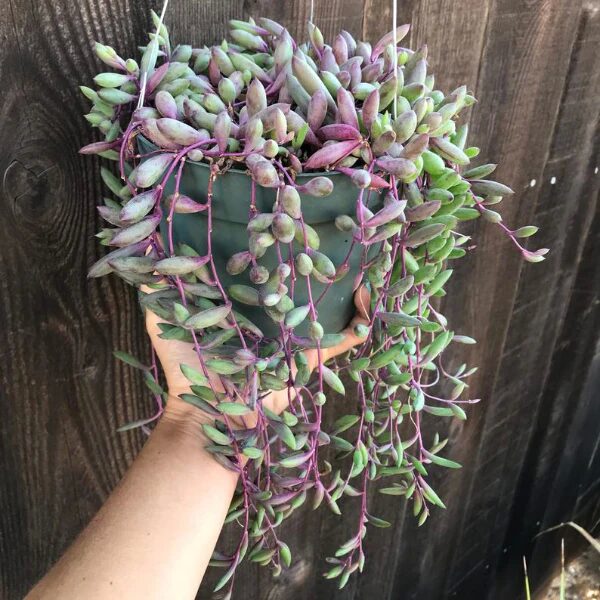The term “jelly bean plant” can refer to a few different plants, but it’s most commonly used to describe Sedum Rubrotinctum, also known as “pork and beans” or “Christmas cheer” plant.
Sedum Rubrotinctum is a small, low-growing succulent with delicate, jelly bean-shaped leaves that range in color from green to pink to reddish-brown, called a Pink Jelly bean Succulent plant, depending on the amount of sunlight and water it receives. It is native to Mexico and is popular as a houseplant or in outdoor rock gardens.

The jelly bean plant is easy to care for and doesn’t require much water, making it an ideal plant for beginners. It thrives in bright, indirect light and prefers well-draining soil. Overwatering can cause root rot, so it’s important to let the soil dry out between waterings.
Reasons to Add ‘Pink Jelly Bean’ Plant to Your Succulent Collection?
The jelly bean plant, also known as Sedum Rubrotinctum, is a popular succulent that is beloved by many plant enthusiasts. Here are some reasons why the jelly bean plant is the perfect addition to your succulent collection:
- Cute and Quirky Appearance: The pink jelly bean plant gets its name from the shape and color of its leaves, which look like small, plump jelly beans. The leaves can range in color from green to yellow to reddish-brown, and they often have a glossy, smooth texture that makes them very appealing to look at.
- Easy to Care For: The jelly bean plant is a relatively low-maintenance plant that is easy to care for. It prefers bright, indirect light and well-draining soil, and it doesn’t require a lot of water. This makes it a great choice for beginners or anyone looking for a low-maintenance plant.
- Great for Propagation: The jelly bean plant is also a great plant for propagation. It produces offsets or “baby” plants that can be easily separated from the parent plant and rooted in soil or water to create new plants. This makes it a great way to expand your collection or share plants with friends.
- Versatile Use: The jelly bean plant can be used in a variety of ways in your succulent collection. It looks great in a mixed planting with other succulents, or in a hanging basket where its trailing stems can be showcased. It can also be used as a ground cover in outdoor gardens or as a fun addition to indoor displays.
Overall, the jelly bean plant is a fun and quirky succulent that is easy to care for and great for propagation. Its unique appearance and versatility make it a perfect addition to any succulent collection.
Types of ‘Pink Jelly bean Succulent’
1. Sedum Rubrotinctum ‘Aurora’
This is a variety of Sedum Rubrotinctum that has pink and yellow leaves that resemble jelly beans.
The pink coloration is most prominent when the plant is exposed to bright light.

2. Othonna Capensis ‘Ruby Necklace’

This is a trailing succulent with small, cylindrical leaves that are a deep pinkish-red color.
The leaves are arranged along long, thin stems that trail down over the edge of a pot or hanging basket.
3. Graptopetalum Paraguayense
This is a rosette-forming succulent with thick, fleshy leaves that are a pale pinkish-gray color.
The leaves are slightly flattened and have a jelly bean-like shape.

4. Pachyphytum Oviferum

This is a slow-growing succulent with blue-green leaves that turn pink or purple under bright light.
The leaves are thick and round, with a jelly bean-like shape.
These are just a few examples of pink jelly bean succulents. There are many other types of succulents with similar leaf shapes and pink coloration, so it’s possible that the specific plant you’re thinking of might be a different variety.
FAQs
Q1: What is a pink jelly bean succulent plant?
The pink jelly bean succulent plant is a type of succulent with small, round leaves that are pink or reddish in color and have a jelly bean-like shape. There are several species of succulent plants that could be described as pink jelly bean plants, including Sedum rubrotinctum ‘Aurora’, Graptopetalum paraguayense, Pachyphytum oviferum, and Othonna capensis ‘Ruby Necklace’.
Q2: How do I care for my pink jelly bean succulent plant?
The care requirements for pink jelly bean succulent plants will vary depending on the specific species, but in general, they prefer bright, indirect light and well-draining soil. They don’t require a lot of water, so be sure to let the soil dry out completely between waterings. They can be propagated from stem or leaf cuttings and will benefit from regular fertilization during the growing season.
Q3: Can I grow a pink jelly bean succulent plant indoors?
Yes, pink jelly bean succulent plants can be grown indoors as long as they receive adequate light. They can be grown in a sunny windowsill or under grow lights. Be sure to choose a well-draining potting mix and a container with drainage holes to avoid overwatering.
Q4: How do I propagate my pink jelly bean succulent plant?
Pink jelly bean succulent plants can be propagated from stem or leaf cuttings. To propagate from a stem cutting, simply snip off a piece of stem with several leaves and allow it to dry out for a day or two. Then, plant the cutting in well-draining soil and keep it lightly moist until roots form. To propagate from a leaf cutting, remove a leaf from the plant and allow it to dry out for a day or two. Then, place the leaf on top of well-draining soil and mist it lightly until roots and a new plant form.
